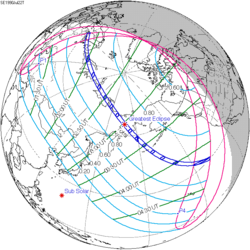| Annular eclipse | |
| Gamma | 0.4705 |
|---|---|
| Magnitude | 0.9371 |
| Maximum eclipse | |
| Duration | 474 s (7 min 54 s) |
| Coordinates | 7°48′N70°48′W / 7.8°N 70.8°W |
| Max. width of band | 262 km (163 mi) |
| Times (UTC) | |
| Greatest eclipse | 17:07:56 |
| References | |
| Saros | 134 (47 of 71) |
| Catalog # (SE5000) | 9682 |
An annular solar eclipse will occur at the Moon's descending node of orbit on Monday, November 15, 2077, [1] with a magnitude of 0.9371. A solar eclipse occurs when the Moon passes between Earth and the Sun, thereby totally or partially obscuring the image of the Sun for a viewer on Earth. An annular solar eclipse occurs when the Moon's apparent diameter is smaller than the Sun's, blocking most of the Sun's light and causing the Sun to look like an annulus (ring). An annular eclipse appears as a partial eclipse over a region of the Earth thousands of kilometres wide. Occurring about 4 days after apogee (on November 11, 2077, at 17:20 UTC), the Moon's apparent diameter will be smaller. [2]
Contents
- Eclipse details
- Eclipse season
- Related eclipses
- Eclipses in 2077
- Metonic
- Tzolkinex
- Half-Saros
- Tritos
- Solar Saros 134
- Inex
- Triad
- Solar eclipses of 2076–2079
- Saros 134
- Metonic series
- Tritos series
- Inex series
- References
- External links
The path of annularity will be visible from parts of Oregon, southwestern Washington, northeastern California, Idaho, Nevada, Utah, Colorado, Arizona, New Mexico, Texas in the United States, the northeastern Yucatán Peninsula, the western tip of Cuba, Colombia, Venezuela, northern Brazil, Guyana, southern Suriname, and extreme southern French Guiana. A partial solar eclipse will also be visible for parts of North America, Central America, the Caribbean, South America, and West Africa.




































































































